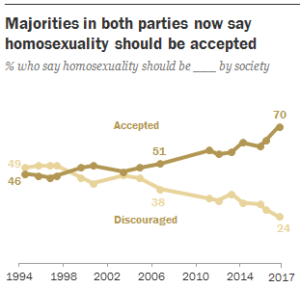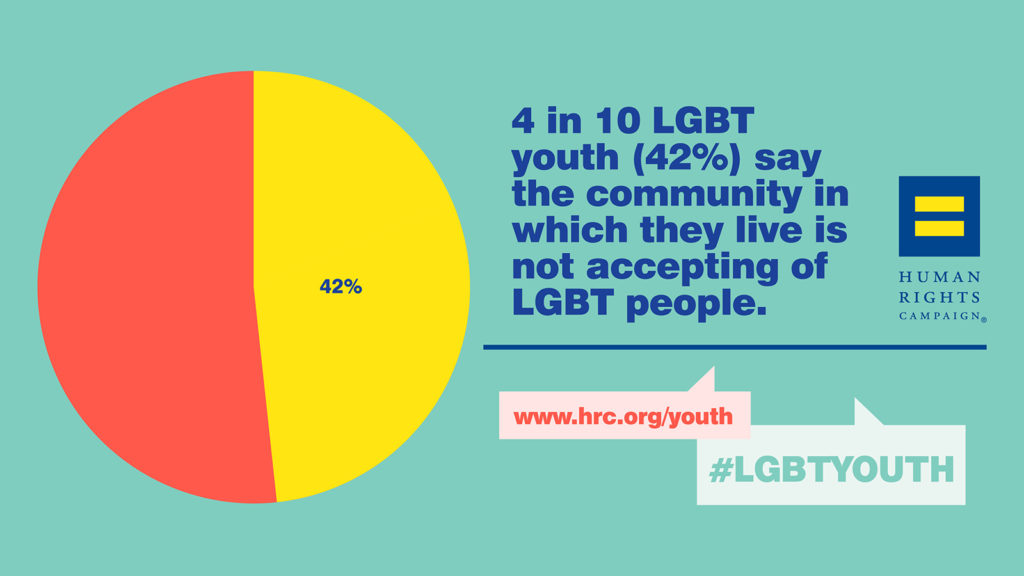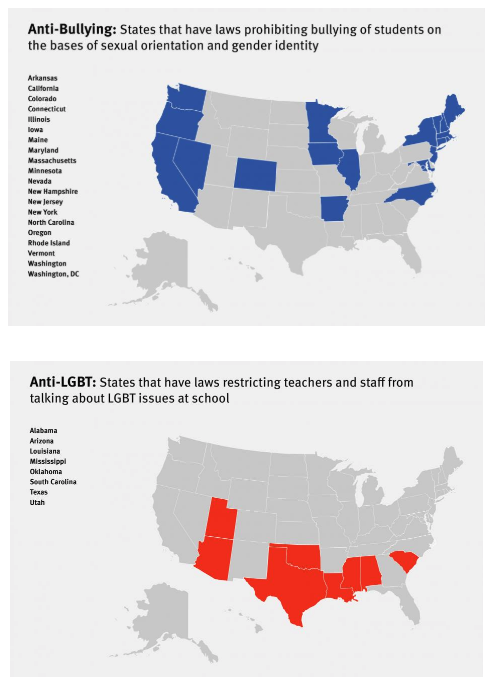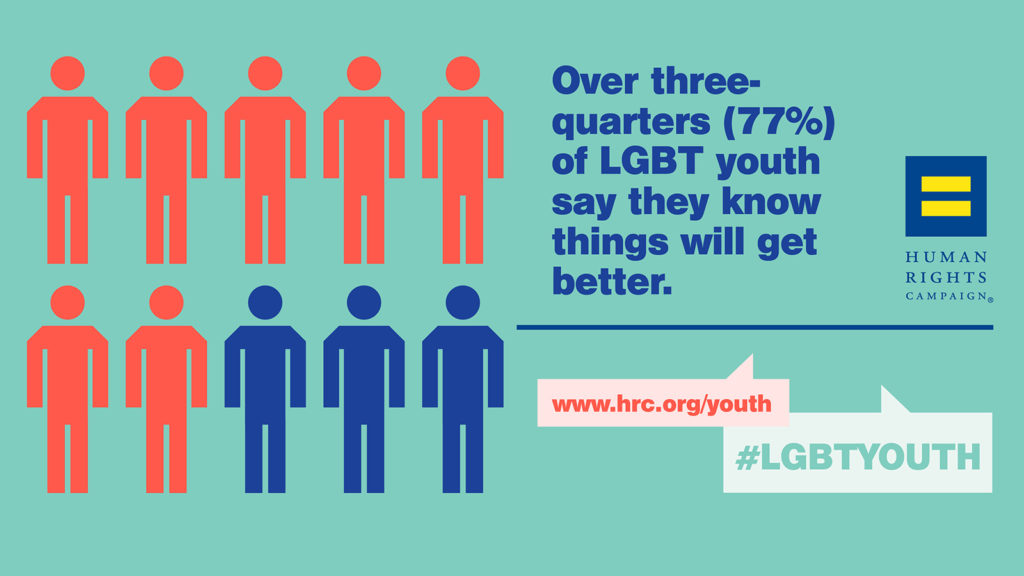Twenty-five years ago, the majority of Americans opposed homosexuality. According to the Pew Research Center, 49% of Americans believed homosexuality should be discouraged by society. In 2017, 24% of people said they believe we shouldn’t accept homosexuality, while 70% supported it. This acceptance rate is up seven percentage points over the past year, and the trend is expected to keep growing over the next few years.
LGBT rights used to be a highly-contested political issue, but more people are accepting of non-heterosexual sexual orientations and support their friends and family when they come out. However, this support doesn’t necessarily translate into healthier and happier lives for LGBT Americans. Many people still experience barriers when adopting children, receiving an education, and claiming healthcare benefits because of their sexual orientation.
Let’s look at some of the top issues facing LGBT youth in America — and particularly LGBT youth of color — to see if this increased acceptance is actually changing our society for the better.
LGBT Students Are More Likely to Experience Bullying and Sexual Assault
For decades, the US Centers for Disease Control has conducted its Youth Risk Behavior Survey every other year. In 2016, the CDC added two new questions. The first question asked students about their sexual orientation and the second questions asked students about the gender of their partners. These questions were optional for states to include, and 27 states decided to add the question to their surveys. This, the CDC believes, allows for an accurate window of survey data that represents the whole country.
- Out of 1.3 million high school kids, roughly eight percent identify as lesbian, gay, or bisexual.
This data is valuable, but it is only the tip of the iceberg, when the CDC compared the results to other questions in the survey, the results were shocking. “Truly heartbreaking,” Laura Kann, the lead author on the survey said.
- 18% of LGB students report being raped at some point in their lives, three times the rate of their heterosexual peers.
- LGB students are twice as likely to be bullied as their peers and to miss school because of fear of violence.
- 60% reported feeling “sad or hopeless,” and 30% have contemplated suicide.
The data is clear: LGBT students make up a significant part of the population, but they are not living on equal terms as their peers.
While the CDC’s survey is comprehensive and detailed, it’s not unique. The Human Rights Campaign released a similar survey, Growing Up LGBT in America, which surveyed more than 10,000 LGBT-identified youth ages 13-17. While 70% of Americans told Pew that they think we should be more accepting of LGBT teens, only 42% of LGBT youth told the HRC their community accepts them. 
Coming Out Is Significantly Harder on LGBT Students of Color
While students of all genders, races, and backgrounds are more susceptible to bullying because of their sexual orientation, young people of color have a significantly harder time navigating friendships and familial relationships than their straight peers.
According to the National Incidence Studies of Missing, Abducted, Runaway, and Thrown-Away Children, 1.7 million youth (ages 12-24) are homeless. Of that group, up to 40% are members of the LGBT community. Youth homeless shelters and LGBT shelters across the country report higher levels of youth of color compared to their white counterparts. For example, the organization Equality Indicators profiled a transitional living program in New York City, where 44% of the population was Hispanic or Latino, 36% black or African American, and 10% white or Caucasian.
LGBT youth of color are significantly less likely to have told their parents about their sexual orientation or gender identity, and are more likely to be part of a religious community that views homosexuality as “wrong and sinful.” Instead, LGBT youth are more likely to bottle their feelings, hide things from their families, and have higher rates of depression.
Most States Have Room to Grow in LGBT School Policies
If local governments and policymakers want to reduce rates of LGBT bullying and homeless youth, they can start with the school system. Like most aspects of LGBT life, the past 15 years have been filled with ups and downs, with some states taking more steps to protect their student bodies than others. As of 2016, only 19 states and the District of Columbia have laws prohibiting bullying of students based on sexual orientation and gender identity.
Conversely, seven states have “No Promo Homo” laws which “expressly forbid teachers of health/sexuality education from discussing lesbian, gay, or bisexual (LGB) people or topics in a positive light – if at all,” reports GLSEN. Some of these laws actually require educators to portray the LGBT lifestyle and behaviors in a negative light. These laws can further promote bullying of LGBT students and increase rates of depression as students are told that their feelings are unnatural or sinful.
But what about the remaining 24 states? Florida doesn’t have an anti-bullying law, but it doesn’t probit the discussion of LGBT issues, either. The rest of these states have policies and laws that fall somewhere in-between, with many counties ignoring LGBT issues and the students who are floundering without support.
For example, the sex education and relationship courses that many students take cover heterosexual topics exclusively. LGBT students are own their own learning about safe sex and healthy relationships. This lack of education and support is reflected in the higher rates of STIs and rates of sexual abuse in the LGBT community. We may not be explicitly discriminating against our LGBT students, but by ignoring their needs we are actively harming them.
How Can We Support LGBT Youth?
Internal acceptance of LGBT youth is only the bare minimum to helping these students grow up in a healthy environment where they feel supported. As allies in the community, we can be a voice for the vulnerable and advocate for greater inclusion in school and policies that support LGBT students.
There is good news, though. Most LGBT youth, regardless of their background and community, feel like life will get better for them. They are confident that our society is heading in the right direction, with greater acceptance rates, support systems, education policy, and laws protecting LGBT citizens. It’s our job to live up to the expectations of 77% of LGBT youth, while giving hope to the remaining 23% who worry about the future.
Follow Family Resources to learn how you can support LGBT youth in Pinellas and Manatee counties, and particularly LGBT homeless youth, to create a better world for the next generation.


